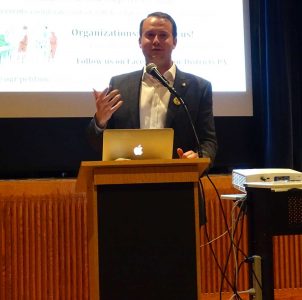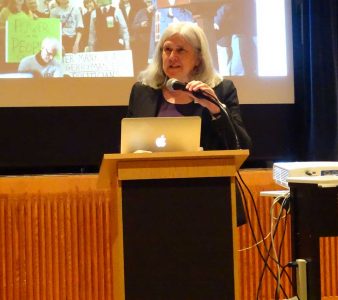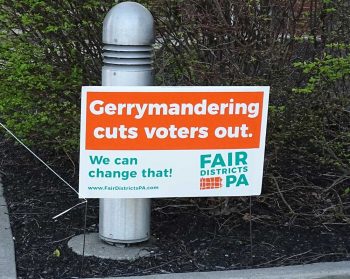By JP Phillips, Staff Writer, The Times
Gerrymandering—what it is, how it’s done, how it disenfranchises voters, and how to end it—was the subject of two April town halls held jointly by State Representative Eric Roe (R-158) and Fair Districts PA Chair Carol Kuniholm.
Because of population shifts, congressional and state legislative boundaries are revised every 10 years after the federal census. Each state has their own rules regarding how this is accomplished.
In Pennsylvania, elected politicians draw the lines—two from the majority party, two from the minority party, and one appointed by the state supreme court. Because our supreme court is elected, invariably one party will have the majority influence. The maps must then be voted on by both the house and the senate, then signed by the governor. The only guidelines for drawing these lines are listed in Article II, section 16 of the PA constitution, stating that districts must be “composed of compact and contiguous territory as nearly equal in population as practicable. Unless absolutely necessary no county, city, incorporated town, borough, township or ward shall be divided.”
During the last cycle, the new legislative districts were subject to litigation and much wrangling over the partisan redraw — and still, even then critics were unhappy with the final result, which led to overwhelming majorities for the Republicans in both houses of the state legislature, despite Pennsylvania having more registered Democrats than Republicans.
The term “gerrymandering” was coined in 1812, when Massachusetts governor Elbridge Gerry approved a state senate map that had one district shaped like a salamander in order capture the voters that favored his party.
Due to today’s sophisticated data manipulation software, it has become easier to draw those lines considering not only population and geography, but also voters party affiliations and turnout in great detail.
Kuniholm says this results in unfair representation. That has played out both for federal Congressional seats — much in the headlines earlier this year — and state legislative seats.
Chester County, under the maps the courts threw out earlier this year, was carved out and pieced together with other counties for its congressional districts. It had three members of Congress, with only one living in Chester County — with the 7th, which was held by Delaware County’s Patrick Meehan, who resigned last week; the 16th, represented by Lloyd Smucker and the 6th, represented by Ryan Costello. Prior to Smucker’s election, the 16th was long represented by East Marlborough’s Joe Pitts — meaning the county had two residents in Congress, dating back to at least 2000, prior to 2016.
Montgomery, the third most populous county in the state, had five representatives, with not one living there.
“Mathematically, Pennsylvania is the worst,” Kuniholm observed when comparing our old maps with other states. She continued, “The practice allows the party in charge to manipulate district lines for personal or party advantage. This was done to deprive us and our communities a voice.”
The state Supreme Court threw out our current congressional map and replaced it for the upcoming primaries and elections — spurring much litigation, but an action ultimately held up by federal courts.
Chester County is now in one district (the 6th), and will stay there until 2022, when new maps based on the 2020 census will be in effect.
Roe is spearheading the effort to fix the process permanently with an independent method run by non-politicians, that only considers geography and population.
To fix the process, Republican Roe along with Democratic State Representative Steve Samuelson (D-135, Bethlehem area) introduced House Bill (HB) 722. Senate Bill (SB) 22 is similar.
In general, the bill calls for an 11-member citizen commission (no politicians or lobbyists), a transparent process with public feedback meetings around the state, and no consideration of anything but what is described in article II, Section 16—no voter turnout or party affiliation information. Should no agreement be reached, the state Supreme Court would appoint a “special master” to redraw the lines—similar to what was done this year to correct Pennsylvania’s old congressional maps.
The bill was assigned to the House State Government Committee for consideration almost a year ago, where it stalled.
Before the bill can advance to the entire house, it must be approved by this committee for it to go to the house floor for consideration. Because this bill would mean a change to the state’s constitution, the bill would have to be approved by the house and senate two years consecutively, and then placed on the 2020 ballot for the voters to decide. That means that both the state house and senate must pass their bill this year in order for it to be in effect for the 2020 census. The last regularly-scheduled session meeting is less than two months away, the end of June.
And because of a move by one powerful committee chair — with the assistance of a local State Representative — the bill is in trouble.
After sitting in committee since May 8 of last year with no action, Roe proposed a “discharge resolution,” which would force the bill out of the committee and onto the house floor for debate.
The next day, the Republican committee chair Daryl Metcalfe (R-12, north of Pittsburgh) added an amendment to the bill that in essence removed the independent citizens commission and put the job of drawing lines back in the hands of elected politicians. It’s actually even more partisan than the current process observers say— there would be four from the majority party, and two from the minority party.
It passed out of the committee on party lines. All committee Republicans, including Stephen Barrar (R-160) who represents four municipalities in southeast Chester County, voted for the amendment, all Democrats voted against.
Metcalfe explained his changes in a phone interview with the The Times’ .
He said he thinks that legislators are best qualified to draw the maps because they are also citizens—but elected by the people. Influences such as campaign donations are public record. Pennsylvanians would not have any way of knowing about “appointed” individuals, as called for by HB722.
He would not support the bill even if there was a different way to select a citizen commission. He feels that Pennsylvanians “select” by going to the voter booths to elect their representatives and senators.
Metcalfe felt his amendment was better than the current process because the supreme court and the governor would no longer have a say. He stated that the “new” maps recently put in place tears up his personal federal district, dividing school districts and townships. It puts his home in Conor Lamb’s district, he said, making it more difficult for him to someday run for the office.
Roe, still new to the ways of Harrisburg, was surprised by Metcalfe’s move.
“The bill had 110 co-sponsors—more than any other bill this session,” Roe lamented. More than half the house co-signed his bill.
So what happens now? Roe explained the possibilities.
Roe and Samuelson can amend the bill to address some of the State House member’s concerns with the original draft. For example, some objected to the appointment of a “special master,” feeling that it puts too much power in the hands of one person. Or a new bill can be drafted, keeping the essence of the original with changes that address the master.
There is also Senate Bill 22 which has been debated in the Senate’s State Government Committee. According to the FairDistrictsPA.org website, there seems to be agreement that the current process is not optimal, and there is a good faith effort to get it to the floor for a vote (this bill can start in either the house or the senate).
“According to what we’ve heard from (Senate Majority Leader) Jake Corman and (Senate President Pro-Tempore) Joe Scarnati, they are open to modifications and likely to bring it up for a vote once it is passed out of committee,” Roe said in an email interview. “Once that happens, however, we will need the Speaker of the House (State Rep. Mike Turzai) to select a good committee for it to be placed in when it comes over to the House. If it’s placed in the House State Government Committee, that could be very bad, as we have seen with my bill.”
Via email on May 3, Roe also pointed The Times to outgoing House Majority Leader Dave Reed’s 5/2 statement on suggested new bills to reform government, including how the state redistricts. He is suggesting creating an independent redistricting commission bill that uses a system similar to how juries are selected. (The other bills concern including registered third-party voters in primaries and legislative committee chair term limits.)
Roe included in his email a quote from Reed regarding his redistricting reform efforts.
“Eric Roe has been the key to the introduction of this redistricting reform proposal,” Reed wrote in comments supplied to The Times by Roe. “His persistence and dedication to the creation of an independent commission to take redistricting out of the politicians’ hands has been a driving force to moving this important government reform to the forefront.”
A resident attending the April 26 town hall asked what constituents can do to move the process forward. Kuniholm recommended calling legislators, especially the Speaker of the House, Metcalfe, and the Chester County GOP officials.
When asked about HB722 support from local officials, Roe said that “All of Chester County’s state senators have co-sponsored it. More than half of Chester County’s House members have co-sponsored it (Roe, Milne, Comitta, Kampf and Corbin in that order). Hennessey, Barrar, Lewis and Lawrence have not yet signed on.”
Barrar — with his seat on the State Government committee — may hold the fate of the process, as well as the potential wrath of angry voters this fall, in his hands.
Turzai did not return The Times’ request for comment.
If nothing changes, whichever party controls the house and senate will change the lines. If the “blue wave” is coming as many people predict, it’s just as possible that Democrats will be in charge come 2020, and as Roe says, “both parties play the game.”
During an April 16 rally in Harrisburg, a constituent held up a poster that summed up the effort perfectly, according to Kuniholm. It read, “Not Red. Not Blue. Just Fair.”









